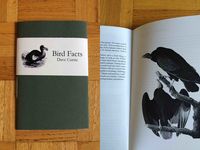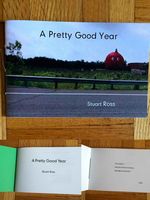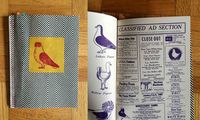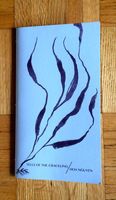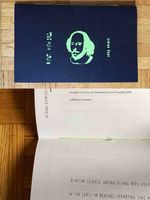Beautiful Chapbooks
By Kate Sutherland
Chapbooks are versatile. They can take a multitude of forms and serve a multitude of functions. It’s generally a lengthy process for a regular book to make its way into print, but a chapbook can enter the world at lightning speed: print, copy, staple. Thus within its pages, one can find marvellously fresh and timely work. Of course, chapbook production can also be more elaborate. Very small print runs open up the possibility of employing a range of labour-intensive processes: handmade paper, hand-sewn bindings, unusual layouts, illustrations, insets, maybe some letterpress printing. Each chapbook becomes a work of art. And the smaller page count of chapbooks invites an organic relationship between form and content. Certainly a chapbook can be a multi-author anthology or an eclectic single-author collection. But it can also be a small body of work that belongs together, undiluted by all of the other work that might surround it in a larger collection.
Below, I’m going to highlight some of the beautiful chapbooks I’ve acquired in recent years. I have huge respect for printed and stapled chapbooks that quickly and economically get excellent writing into the world. Many such chapbooks are a treasured part of my book collection. But since this is a follow-up to yesterday’s post on the theme of books as physical objects, my focus here is on chapbooks that I appreciate for their physical properties as well as the excellent reading they provide. My list is alphabetical by press and, rather than putting forward lengthy, repetitive (hand-sewn binding! beautiful paper!) descriptions, I’m restricting myself to a few sentences on what I particularly like about each.
Apt. 9 Press: Bird Facts by Dave Currie (2014)
I love pretty much everything Apt. 9 Press publishes, and could have included any number of their chapbooks on this list. But Bird Facts by Dave Currie is a chapbook that seems tailor-made for me given my fascination with birds and with natural history texts. Currie’s bird facts are, of course, not entirely factual. The overall form is a cross between a standard guide to birds and a more fanciful bestiary, each entry ultimately a prose poem. And the form of the chapbook with its olive green cover, the dodo illustration that appears thereon, and the other illustrations scattered throughout, beautifully play up its bestiary-ness.
JackPine Press: Lost + Found: Signposts for Steering Through the World by Laura Lamont & Jess Dixon (2015)
There is so much to look at, to touch, and to ponder when leafing through this chapbook. JackPine’s catalogue describes how it’s made: “The book’s design uses millboard wrapped in craft paper and bound with fabric tape and Chicago bolts for the covers. Inset location diagrams represent each poem and also feature as background to the poem’s text on the individual page. Poems are printed on a variety of materials, from imprinted cotton paper to cascading, torn vellum.” The effect is stunning.
Nose in Book: A Pretty Good Year by Stuart Ross (2014)
This is a small, perfect book. Stuart Ross explains in an author’s note at the back that during a difficult year, he found himself writing haiku as a means of coping. Here, they’re laid out one to a page giving the reader space to linger with each one. But the emotional power is cumulative. This sequence has since appeared as a single poem in Ross’s latest full-length collection, A Sparrow Came Down Resplendent, and it’s powerful in that form too. But I love the chapbook version. Like I said, perfect.
PAS DE CHANCE: Pigeon Poems by Chris Chambers (2014)
This gorgeous chapbook feels almost like a collaboration between poet Chris Chambers and publisher/illustrator Ian Phillips. It contains seven of Chambers’ pigeon poems and, in designing the book, Phillips took Chambers’ pigeon theme and ran with it, interleaving photos of pigeon collectors between the poems, and adding his own illustrations of various species of pigeons on the cover, the front, and back pages, as well as a closing section of pigeon-related classified ads. The whole thing is irresistible.
Your CanLit News
Subscribe to Open Book’s newsletter to get local book events, literary content, writing tips, and more in your inbox
Ugly Duckling Presse: Tells of the Crackling by Hoa Nguyen (2015)
The publication of Hoa Nguyen’s Tells of the Crackling chapbook in 2015 was an exciting event, a chance to take home some of her recent work without having to wait for the 2016 release of her latest full-length collection, Violet Energy Ingots. But I love Tells of the Crackling for its form too, its rectangular shape, and the long narrow fronds of the cover illustration, mirroring the long narrow shape of so many of the poems contained within.
WORDS(ON)PAGES: Where Art by Simina Banu (2015)
I love the look of Simina Banu’s Where Art, the neon green lettering and illustration against the black cover, and the binding thread in the exact same shade of green. And I love that the whole book reads sideways, allowing for poems that sprawl and stretch across the widest part of the page, and down multiple pages. Banu’s poems occupy the page in unconventional ways, and the design of the chapbook perfectly serves the poems.
If you’re in Toronto, and you fancy adding to your chapbook collection, your best chance to do so is imminently approaching. Meet the Presses’ annual fall Indie Literary Market takes place on November 19th this year. All of the details are here: http://meetthepresses.wordpress.com/2016/09/16/2016-meet-the-presses-indie-literary-market-bpnichol-chapbook-award-announcement/
The views expressed in the Writer-in-Residence blogs are those held by the authors and do not necessarily reflect the views of Open Book.
Kate Sutherland was born in Scotland, grew up in Saskatchewan, and now lives in Toronto, where she is a professor at Osgoode Hall Law School. She is the author of two collections of short stories: Summer Reading (winner of a Saskatchewan Book Award for Best First Book) and All In Together Girls. How to Draw a Rhinoceros is Sutherland’s first collection of poems.
You can reach Kate throughout the month of October at writer@open-book.ca.
